Chuck Kemeny went into the 2012 Tampa Double IRONevent bent on breaking the recordand he almost did. While he broke the Double IRON bike-portion record with a time of 10 hours, 51 minutes—nearly an hour under the previous record of 11 hours, 39 minutes and an hour under the world record pace at the 140.2-mile marker, he had to pull out due to electrolyte imbalances. Kemeny knew something was off with his body and when his electrolyte imbalances started to create issues he decided to quit. “I would get blood draws and a whole slew of tests done to figure out how it relates to what I’m feeling,” says Kemeny.
Kemeny is relatively new to the triathlon. He started racing in 2006 at the age of 30 with much success. In 2009 he qualified for and competed in the Ironman World Championships and in 2010, he qualified for his professional triathlete license and won the 25th Anniversary of the Virginia Double IRON triathlon which takes place in September each year. “I started coaching in 2009 and turned professional in 2010. I did let my pro card expire this year though. I might turn pro again in the future should I find the time to train and requalify. I am sure if time were not a constraint, I could be competitive as a professional,” he said. Among the many challenges of racing, Kemeny cites nutrition as a huge factor. In 2010 Kemeny decided he wanted to use his talents to raise money for MS research.
“Knowing what a debilitating disease MS can be, I wanted to choose an event that would test me on a number oflevels. I had completed and been successful at the Ironman distance prior to deciding to fund raise. Knowing this, I knew an Ironman was not going to be the challenge I was seeking. I researched a number of utlra events and found the Virginia Double IRON race.”
To Kemeny the challenge of going 4.8 miles swimming, 224 miles cycling, and 52.4 miles running all in one day seemed perfect. He knew he had to train differently; for example he had to teach his body to accept solid foods while cycling and running. To improve his mental training, he trained through the night.
Nutrition was the biggest challenge. “I had to figure out what my nutritional needs would be for the Double IRON. It presented the physical, mental, and strategic challenge I felt was fitting for the cause,” he said. The central problem with a 3,000-calorie workout in Kemeny’s case is the time needed to eat all those calories. “As you get older,” he says, “you get into having a very opportunistic schedule. When you’re getting up at three-something in the morning, how muchearlier are you gonna be getting up to eat?” He shares his experience with athletes he coaches, through his training company, Revolutions Triathlon Coaching.
“The majority of my clients who start are targeting something they’ve never done before.” And that’s what Kemeny is targeting, too: something never done before. “Every year I set my sights and goals higher and higher.”
But after the Tampa Double IRON something set him off and he considered retiring from racing; but when he told his family about his intention
to stop, his son asked him: “Dad, if you stop racing, who’s gonna inspire me?” There are a lot of people out there who love to push themselves, and this is both an admirable and a sometimes obsessive quality. Kemeny balances priorities in training for these things—after all, he has a family—he radically says that “racing should never be first priority.”
“I’m a husband and father first,” says the married father of three, a full-time associate director of infrastructure and operations in the IT department at Florida State University— who just happens to take routine 3,000-calorie-burning-runs in his spare time. And even with a full time job and a family life, Kenemy chooses to race Double IRONs. They have big startup costs, including the food to fuel the race, the vacation time off, and the cost of transporting the family who lovingly comes along and even tag-team races beside. Racing takes some creative planning and budgeting for an endurance athlete to even conceive of getting to the starting line—forget swimming, biking and running heroic distances.
“Life, it’s imperfect. Some people have the perfect training, the perfect race, other people have bumpy training, a bumpy personal life. You’re gonna have highs and lows.” He adds, “People get very obsessive. It’s important that they have something else in their life to focus on in their low points.”
He talks about that golden training time between 3 a.m. Saturday morning and noon, before the slew of kids’ activities, such as cross country and swim meets, debate clubs and the like roll in. So he naturally doesn’t want to waste a minute more than he has to eating. When he coaches his runners, he has to debunk the common theory about training.
“People say ‘You’re over-trained,’ I say, ‘Nah, you’re malnourished.’” He laughs and says, “If you’re fueling correctly you can run 30 to 40 miles a day and not be wasted on the floor.” So he races on, kids in tow, flying by the seat of his pants, always keeping it chill in his own ultra-intense way.





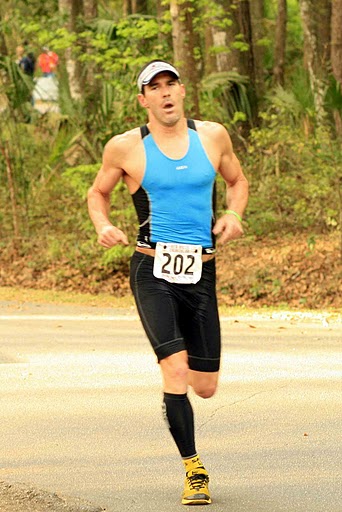
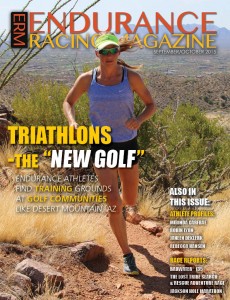

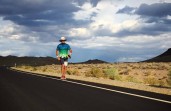
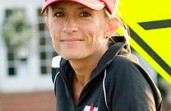
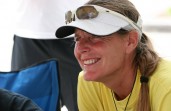


Its a pleasure to be acquainted with Chuck and his family. He definitely sets a standard for hard work and passion for multisport!
I love that, But Daddy, who is going to inspire me? Last year my youngest was trying to read and he said to me, It is just too hard. But I stopped him and I reminded him that mommy was training for an Ironman. That Daddy runs 26.2 miles super fast and that his older brother was going through basic training at the USMA West Point. I told him that for all of us there came a moment when we thought it was too hard but we had to decide, was it worth it to keep trying. It was the first time as a runner/triathlete that I realized that our inspiration could go beyond the athletics. When he looks at us he knows how hard we work and he can apply that to every area of his life. People sometimes think my husband and I are being selfish by being endurance athletes. I like to believe we are giving our kids a gift that most parents are not.